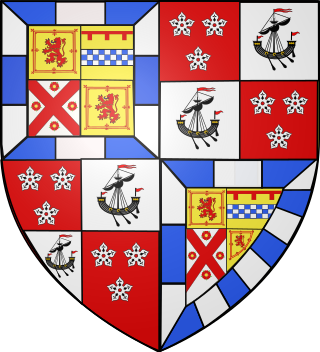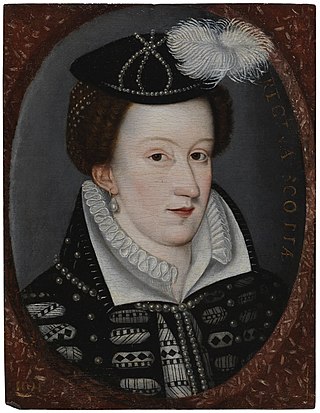Related Research Articles
John Stewart, 4th Earl of Atholl, called the Fair, was a Scottish nobleman and courtier. He was favoured by Mary, Queen of Scots, but later turned against her.
William Ruthven, 1st Earl of Gowrie, 4th Lord of Ruthven was a Scottish peer known for devising the Raid of Ruthven.
The Raid of Ruthven was a political conspiracy in Scotland which took place on 22 or 23 August 1582. It was composed of several Presbyterian nobles, led by William Ruthven, 1st Earl of Gowrie, who abducted King James VI of Scotland. The nobles intended to reform the government of Scotland and limit the influence of French and pro-Catholic policy, and to prevent or manage the return of Mary, Queen of Scots from England. Their short-lived rule of around 10 months is known as the "Ruthven" or "Gowrie Regime".

Captain James Stewart, Earl of Arran was created Earl of Arran by the young King James VI, who wrested the title from James Hamilton, 3rd Earl of Arran. He rose to become Lord Chancellor of Scotland and was eventually murdered in 1595.
Sir William Stewart of Houston was a Scottish soldier, politician and diplomat.
Patrick Gray, 6th Lord Gray, known most of his life as Patrick, Master of Gray, was a Scottish nobleman and politician during the reigns of Mary, Queen of Scots and James VI of Scotland.

Kinneil House is a historic house to the west of Bo'ness in east-central Scotland. It was once the principal seat of the Hamilton family in the east of Scotland. The house was saved from demolition in 1936 when 16th-century mural paintings were discovered, and it is now in the care of Historic Environment Scotland. The house now consists of a symmetrical mansion built in 1677 on the remains of an earlier 16th- or 15th-century tower house, with two rows of gunloops for early cannon still visible. A smaller east wing, of the mid 16th century, contains the two painted rooms. The house is protected as a Category A listed building.
Sir James MacGill, Lord Rankeillor of Nether Rankeillour. was a Scottish courtier and Senator of the College of Justice.
Claude Nau or Claude Nau de la Boisseliere was a confidential secretary of Mary, Queen of Scots, in England from 1575 to 1586. He was involved in coding Mary's letters with cipher keys.
John Seton, Lord Barns was a Scottish diplomat, courtier and judge.
George Young was a Scottish churchman, courtier, member of the Privy Council of Scotland, diplomat, and secretary depute.
James Stewart, 1st Lord Doune (1529-1590) was a Scottish landowner.
Margaret Fleming, Countess of Atholl (1536-1586) was a Scottish courtier and landowner rumoured to be involved in the occult. She served as lady-in-waiting to Mary, Queen of Scots.
Thomas Kerr of Ferniehirst was a Scottish landowner, Roman Catholic and supporter of Mary, Queen of Scots. He and Jean Scott ended the feud between the Scott family and the Kerrs. Thomas and Jean were both involved with supporting Mary, Queen of Scots.

The jewels of Mary, Queen of Scots (1542–1587), are mainly known through the evidence of inventories held by the National Records of Scotland. She was bought jewels during her childhood in France, adding to those she inherited. She gave gifts of jewels to her friends and to reward diplomats. When she abdicated and went to England many of the jewels she left behind in Scotland were sold or pledged for loans, first by her enemies and later by her allies. Mary continued to buy new jewels, some from France, and use them to reward her supporters. In Scotland her remaining jewels were worn by her son James VI and his favourites.
Janet or Jean Scott, Lady Ferniehirst was a Scottish landowner. She was a member of the Border family of Scott who succumbed to an arranged marriage that healed the feud with the family who killed her father. Her marriage to Thomas Kerr of Ferniehirst was successful and she took a role in Scottish politics between the Scottish court and the exiled Mary, Queen of Scots.
William Stewart of Caverston and Traquair, was a Scottish landowner and Captain of Dumbarton Castle.

Dorothea Stewart, Countess of Gowrie was a Scottish aristocrat. The dates of the birth and death of Dorothea Stewart are unknown.
James Home of Coldenknowes was a Scottish landowner, soldier, and keeper of Edinburgh Castle.
Albert Fontenay or Fontaine was a French servant of Mary, Queen of Scots and acted as her diplomat in Scotland in 1584. Fontenay wrote a frequently cited description of the young James VI of Scotland. Some of his correspondence with Mary, Queen of Scots, was decipherered and published by Sheila R. Richards in 1974.
References
- ↑ William Mackay, Fraser Chronicles (Edinburgh, 1905), pp. 268-71.
- ↑ Accounts of the Treasurer, vol. 13 (Edinburgh, 1978), p. 281.
- ↑ Roderick J. Lyall, Alexander Montgomerie: Poetry, Politics, and Cultural Change in Jacobean Scotland (Arizona, 2005), p. 89 modernised here.
- ↑ Thomas Thomson, Collection of Inventories (Edinburgh, 1815), pp. 306-8.
- ↑ William Boyd, Calendar State Papers Scotland: 1581-1583, vol. 6 (Edinburgh, 1914), p. 289.
- ↑ Thomas Thomson, Collection of Inventories (Edinburgh, 1815), pp. 316-320.
- ↑ Bowes Correspondence, p. 579.
- ↑ Calendar State Papers Scotland: 1581-1583, vol. 6 (Edinburgh, 1910), p. 638.
- ↑ William Boyd, Calendar State Papers Scotland: 1584-1585, vol. 7 (London, 1913), p. 43 no. 40.
- ↑ William Boyd, Calendar State Papers Scotland, vol. 7 (Edinburgh, 1913), p. 277 no. 248.
- ↑ William Boyd, Calendar State Papers Scotland, vol. 7 (Edinburgh, 1913), pp. 292-3 no. 266.
- ↑ Letters and papers relating to Patrick, Master of Gray (Edinburgh, 1835), p. 6.
- ↑ William Murdin, Collection of State Papers (London, 1759), pp. 552-3: Calendar State Papers Scotland, vol. 6 (Edinburgh, 1910), p. 279 no. 298.
- ↑ Calendar State Papers Scotland, vol. 6 (Edinburgh, 1910), p. 277 no. 298: William Murdin, Collection of State Papers (London, 1759), p. 551: Fontenay's dispatch was written late in 1584, and is misplaced in the calendars, Maurice Lee, John Maitland (Princeton, 1959), p. 62 fn. 63.
- ↑ Sheila R. Richards, Secret Writing in the Public Records (HMSO, 1974), pp. 25-8.
- ↑ Gordon Donaldson, Register of the Privy Seal: 1581-1584, vol. 8 (Edinburgh, 1982), p. 419 no. 2399.
- ↑ Annie I. Cameron, Warrender Papers, vol. 1 (Edinburgh, 1931), pp. 169-170.
- ↑ David Calderwood, History of Church of Scotland, vol. 4 (Edinburgh, 1843), pp. 400, 413.
- ↑ David Calderwood, History of Church of Scotland, vol. 4 (Edinburgh, 1843), pp. 410-11: Calendar State Papers Scotland, vol. 7 (Edinburgh, 1913), p. 555 no. 529.
- ↑ Calendar State Papers Scotland, vol. 7 (Edinburgh, 1913), p. 291 no. 266.
- ↑ Agnes Strickland, Letters of Mary, Queen of Scots, vol. 3 (London, 1843), p. 168.
- ↑ Calendar State Papers Scotland, vol. 7 (Edinburgh, 1913), pp. 681-2 no. 662.
- ↑ Joseph Bain, Calendar of Border Papers, vol. 1 (Edinburgh, 1894), pp. 185-6
- ↑ James David Marwick, Extracts from the records of the Burgh of Edinburgh: 1573-1589 (Edinburgh, 1882), p. 427.
- ↑ John Shedden-Dobie, 'Mason's Protocol Book', Archaeological Collections Ayrshire & Galloway (Edinburgh, 1889), pp. 184-6.
- ↑ Joseph Bain, Calendar of Border Papers, vol. 1 (Edinburgh, 1894), p. 165.
- ↑ William Boyd, Calendar State Papers Scotland: 1585-1586, vol. 8 (Edinburgh, 1914), p. 157 no. 205.
- ↑ Thomas Thomson, Collection of Inventories (Edinburgh, 1815), pp. 316-320: William Boyd, Calendar State Papers Scotland: 1585-1586, vol. 8 (Edinburgh, 1914), p. 188 no. 241.
- ↑ Calendar State Papers Scotland: 1585-1586, vol. 8 (Edinburgh, 1914), pp. 157, 188, 337.
- ↑ David Masson, Register of the Privy Council of Scotland: 1585-1592, vol. 4 (Edinburgh, 1881), pp. 220-1, 214-5.
- ↑ HMC Salisbury Hatfield, vol. 4 (London, 1892), p. 30.
- ↑ Robert Vans-Agnew, Correspondence of Sir Robert Waus of Barnbarroch, vol. 2 (Edinburgh, 1887), p. 457.
- ↑ Michael Pearce, 'Anna of Denmark: Fashioning a Danish Court in Scotland', The Court Historian, 24:2 (2019), p. 148.
- ↑ John Mackenzie, A chronicle of the kings of Scotland (Edinburgh, 1830), p. 137
- ↑ William Boyd, Calendar State Papers Scotland: 1581-1583, vol. 6 (Edinburgh, 1914), p. 330.